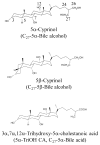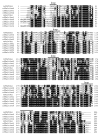Identification and characterization of 5α-cyprinol-sulfating cytosolic sulfotransferases (Sults) in the zebrafish (Danio rerio)
- PMID: 28807679
- PMCID: PMC5675747
- DOI: 10.1016/j.jsbmb.2017.08.005
Identification and characterization of 5α-cyprinol-sulfating cytosolic sulfotransferases (Sults) in the zebrafish (Danio rerio)
Abstract
5α-Cyprinol 27-sulfate is the major biliary bile salt present in cypriniform fish including the zebrafish (Danio rerio). The current study was designed to identify the zebrafish cytosolic sulfotransferase (Sult) enzyme(s) capable of sulfating 5α-cyprinol and to characterize the zebrafish 5α-cyprinol-sulfating Sults in comparison with human SULT2A1. Enzymatic assays using zebrafish homogenates showed 5α-cyprinol-sulfating activity. A systematic analysis, using a panel of recombinant zebrafish Sults, revealed two Sult2 subfamily members, Sult2st2 and Sult2st3, as major 5α-cyprinol-sulfating Sults. Both enzymes showed higher activities using 5α-cyprinol as the substrate, compared to their activity with DHEA, a representative substrate for mammalian SULT2 family members, particularly SULT2A1. pH-Dependence and kinetics experiments indicated that the catalytic properties of zebrafish Sult2 family members in mediating the sulfation of 5α-cyprinol were different from those of either zebrafish Sult3st4 or human SULT2A1. Collectively, these results imply that both Sult2st2 and Sult2st3 have evolved to sulfate specifically C27-bile alcohol, 5α-cyprinol, in Cypriniform fish, whereas the enzymatic characteristics of zebrafish Sult3 members, particularly Sult3st4, correlated with those of human SULT2A1.
Keywords: 5α-cyprinol; Cytosolic sulfotransferase; SULT; Sulfation; Zebrafish.
Copyright © 2017 Elsevier Ltd. All rights reserved.
Figures






Similar articles
-
A comparative study of the sulfation of bile acids and a bile alcohol by the Zebra danio (Danio rerio) and human cytosolic sulfotransferases (SULTs).J Steroid Biochem Mol Biol. 2011 Nov;127(3-5):307-14. doi: 10.1016/j.jsbmb.2011.07.011. Epub 2011 Aug 4. J Steroid Biochem Mol Biol. 2011. PMID: 21839837 Free PMC article.
-
A novel hydroxysteroid-sulfating cytosolic sulfotransferase, SULT3 ST3, from zebrafish: identification, characterization, and ontogenic study.Drug Metab Lett. 2009 Dec;3(4):217-27. doi: 10.2174/187231209790218154. Drug Metab Lett. 2009. PMID: 19995333
-
Characterization and ontogenic study of novel steroid-sulfating SULT3 sulfotransferases from zebrafish.Mol Cell Endocrinol. 2008 Nov 6;294(1-2):29-36. doi: 10.1016/j.mce.2008.06.014. Epub 2008 Jul 2. Mol Cell Endocrinol. 2008. PMID: 18644423
-
Pharmacogenetics of human cytosolic sulfotransferases.Oncogene. 2006 Mar 13;25(11):1673-8. doi: 10.1038/sj.onc.1209376. Oncogene. 2006. PMID: 16550167 Review.
-
Updated perspectives on the cytosolic sulfotransferases (SULTs) and SULT-mediated sulfation.Biosci Biotechnol Biochem. 2017 Jan;81(1):63-72. doi: 10.1080/09168451.2016.1222266. Epub 2016 Sep 21. Biosci Biotechnol Biochem. 2017. PMID: 27649811 Free PMC article. Review.
References
-
- Alnouti Y. Bile Acid sulfation: a pathway of bile acid elimination and detoxification. Toxicol Sci. 2009;108:225–246. - PubMed
-
- Hofmann AF. Detoxification of lithocholic acid, a toxic bile acid: relevance to drug hepatotoxicity. Drug Metab Rev. 2004;36:703–722. - PubMed
-
- Otterness DM, Wieben ED, Wood TC, Watson RWG, Madden BJ, Mccormick DJ, Weinshilboum RM. Human liver dehydroepiandrosterone sulfotransferase: molecular cloning and expression of cDNA. Mol Pharmacol. 1992;41:865–872. - PubMed
-
- Kitada H, Miyata M, Nakamura T, Tozawa A, Honma W, Shimada M, Nagata K, Sinal CJ, Guo GL, Gonzalez FJ, Yamazoe Y. Protective role of hydroxysteroid sulfotransferase in lithocholic acid-induced liver toxicity. J Biol Chem. 2003;278:17838–17844. - PubMed
Publication types
MeSH terms
Substances
Grants and funding
LinkOut - more resources
Full Text Sources
Other Literature Sources
Molecular Biology Databases

